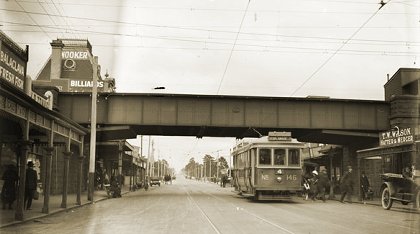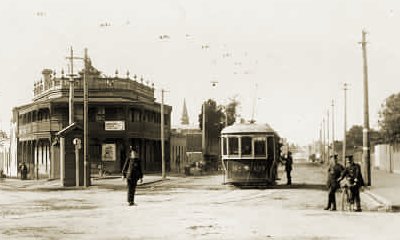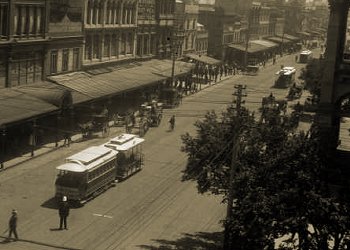Melbourne Tram Museum
- Follow Melbourne Tram Museum on Twitter
- Follow Melbourne Tram Museum on Facebook
- Follow Melbourne Tram Museum on Instagram
- Follow Melbourne Tram Museum on Pinterest
- Follow Melbourne Tram Museum on Tumblr
- Subscribe to Melbourne Tram Museum's RSS feed
- Email Melbourne Tram Museum
Fares please! An economic history of the Melbourne & Metropolitan Tramways Board
Seven plus one
Act number 2995 was passed by the State Parliament to found the Melbourne & Metropolitan Tramways Board (M&MTB), merging the tramway entities listed in the following table:
| Traction |
Capital value
|
|
|---|---|---|
| Melbourne Tramways Board | Cable | £2,170,933 |
| Prahran & Malvern Tramways Trust | Electric | £851,998 |
| Hawthorn Tramways Trust | Electric | £299,896 |
| Melbourne, Brunswick & Coburg Tramways Trust | Electric | £187,009 |
| Fitzroy, Northcote & Preston Tramways Trust | Electric | £129,809 |
| Footscray Tramways Trust | Electric | £88,747 |
| Northcote City Council tramway | Cable | £46,169 |
The Melbourne Tramways Board was taken over on 1 November 1919, the other tramways following on 2 February 1920. Under the terms of the Act, the surplus of the Melbourne Tramways Board, being £866,320, was transferred to the Melbourne & Metropolitan Loan Redemption Fund, less an amount of £100,000. However, this net amount was less than was projected in the legislation, and subsequently the M&MTB had to finance a shortfall of £60,817 for payment into the Fund out of its first year’s revenue.
 Q 146 at Carlisle Street Balaclava rail overbridge, circa 1923. Tram
en route to St Kilda Esplanade on route 4
Q 146 at Carlisle Street Balaclava rail overbridge, circa 1923. Tram
en route to St Kilda Esplanade on route 4- Photograph courtesy Public Record Office Victoria.
The magnificently named Melbourne & Metropolitan Loan Redemption Fund
was actually a device used by the State Government to seize the profits
from the cable tramway operation. These profits were actually owned
by the 12 municipal councils that had funded the construction of the
cable system on the security of their rates. The councils protested
vigorously, but they were appeased by the Government undertaking to
write off the same amount from council debentures due for payment in
1936.
The reason for this underhand action was that the State Government had a loan of £4,000,000 due for payment in the London financial markets, and it was having trouble rolling over this amount into a new loan with favourable terms. It was strongly hinted that if 25% of this amount was paid off, then the State Government could receive its desired terms. The problem was that the Government did not have the £1,000,000 necessary, so it resolved to raid the cable tramway profit and solicit the remaining shortfall from whatever source it could.
There was a great deal of resistance within the State Parliament with regard to the passing of the Act, as there was opposition to the establishment of a monopoly tramway operator such as MTOC. In order to gain the necessary support, part of the Act included an annual obligation to pay into Consolidated Revenue a dividend to fund the following bodies on a pound-for-pound basis with State Government:
- Liquor Licensing Fund
- Fire Brigades Board
- Infectious Diseases Hospital
It was estimated that the annual amount required would be no more than £62,500. This expectation was optimistic, and the obligation was to be a burden on the M&MTB for many years to come.
The municipal councils strongly objected to this charge on the future Board’s revenue. However, during the negotiations to establish the basis for the legislation, the councils were threatened by the Hon. Arthur Robinson MLC that unless they acceded on this requirement, he would ensure that these charges would be levied against the municipalities concerned on an annual basis. The councils were left with no choice but to consent to this proposal.
As a further inducement to opponents within Parliament, during the first year of operations the Board also transferred £230,807 to State Treasury, and distributed £30,000 to the various municipalities through which it operated. It also assumed the obligations of the Prahran and Malvern City Councils in relation to the railway regrading works in Armadale, paying £4,841 to the Victorian Railways.
This was not the only burden under which the Board would labour. Under the terms of the Act, the M&MTB had to maintain a reserve fund amounting to 4% of the capital cost of the undertaking. This was significantly more than the municipal tramway trusts were previously required to maintain, being only 2.5% of renewable costs. Effectively, this meant that the cable tram system had to underwrite the cost of the suburban electric tram systems the Board had taken over.
Further costs that the Board had to underwrite included:
- provision of street lighting along its routes – averaging £9,000 per annum over the first ten years of operation.
- maintenance of the road surface between its track rails and eighteen inches on the outside of the rails – averaging £15,000 per annum over the first ten years of operation. This did not include the cost obligation of providing the road surface for new construction. In the early years, the Board-maintained surface was usually superior to the rest of the road surface, so motorists preferred to drive on the tram tracks, thus increasing Board’s maintenance costs.
- ongoing obligations to contribute to road widening, removal of railway level crossings and rounding of street corners along tram routes.
All these obligations would restrict the ability of the M&MTB to develop its tramway system at the desired rate, so that it never reached the extent planned under the 1923 General Scheme [8], prepared under the terms of the Act.
The powers granted under the Act were also quite limited. Any new construction of tramlines in excess of £10,000 had to be submitted to the Parliamentary Standing Committee on Railways, before proceeding to passing of an Act authorising construction. It then had to receive the assent of the Governor-in-Council before any work could proceed. This would prove to be a brake on expansion plans, as the Victorian Railways was envious of the tramways suburban traffic, and opposed construction of tramlines in areas that might siphon off its clientele. Needless to say, the VR Commissioners had significant influence in the Standing Committee, although the £10,000 limit was increased to £20,000 in the subsequent 1920 Act (No 3074).
Furthermore, the M&MTB was prohibited from the field of power generation, and it had to receive Ministerial approval prior to the purchase of any non-Australian produced or manufactured goods. The only significant policy area where it did not have any type of Government oversight was for the conversion of existing cable tram routes to electric traction.
One provision in the Act that did not get passed by Parliament was a provision for the M&MTB to take over the VR tramlines. Instead, these two lines would remain under the control of VR until their closure in the 1950s.
 M&MTB S class No 139, circa 1920.
M&MTB S class No 139, circa 1920. - Photograph courtesy Coburg Historical Society.
The first Chairman of the Board was Alex Cameron, former Chairman of the P&MTT and a powerful advocate for electric tramways since the first decade of the twentieth century. Initially, the M&MTB was organised into three divisions for administrative purposes:
- Cable Division – former MTB and Northcote cable tramways
- Eastern Division – PMTT and HTT electric tramways
- Northern Division – MBCTT, FNPTT and FTT electric tramways.
By 1925 these arrangements ceased and the tramway was then run as a single entity.
One of the tasks that the Board faced was the standardisation of employee conditions. This required a lengthy period of negotiation to achieve, as the conditions varied significantly between the various Trusts, and the employees were eager to achieve the best possible outcome. However, post-war inflation led to a rapid demand for wage increases in 1920, which was partly assuaged by two fare rises comprising a total increase of 39%.
This was not the only challenge that the Board faced on its founding. The Hawthorn tramway permanent way was anything but permanent, and would require expenditure of more than £100,000 to bring to an acceptable standard. The Northcote cable tramway would also require some remedial works to the sum of around £7,000.
Furthermore, the incompetent management of the Footscray Tramways Trust had left the M&MTB with a completed tramway that was inoperable, due to its complete failure to negotiate provision of a power supply with the Victorian Railways. This was not to be remedied for eighteen months after the Board acquired the assets of the Trust. Consequently, the capital tied up in the tramway was not generating income to service the debt used to fund its construction.
After an extensive period of negotiation the Government came to an agreement to purchase the North Melbourne Electric Tramways & Lighting Company (NMETL) from its British parent for a total of around £110,000. Act No 3247 was passed to allow the M&MTB to takeover this system, which came into effect on 1 August 1922. This required the transfer of £31,250 from the Board to the State Government to assume the tramway assets and operation of the NMETL. It then came under the control of the Northern Division of the M&MTB.
The initial objective of the M&MTB was to convert the cable tram system to electric traction. There were a number of reasons for this goal. Firstly, most of the infrastructure of the cable tram system was 30 years old and approaching the end of its economic life. Renewal of this infrastructure would cost significantly more than complete replacement by electric tramways.
 Cable cars in Swanston Street looking north from Collins Street.
Cable cars in Swanston Street looking north from Collins Street. - Photograph courtesy State Library of Victoria.
Secondly, despite the addition of auxiliary drives in several engine
houses to increase cable speed, during peak hours the busiest routes
in Swanston and Collins Streets were saturated with cable tramcars,
and no additional services could be added, so no additional passenger
capacity could be achieved in these streets. The limiting factor here
was the small size of a standard cable tram set, having a crush loading
of 54 people in 38 linear feet of roadway. In comparison, the crush
load of a standard W type electric bogie car is 150 in 48 linear feet
of roadway, which in effect increases utilisation of the road space
by 220% from a passenger-carrying capacity perspective.
Finally, the greater carrying capacity of electric tramcars would enable a reduction in the number of peak hour services required to meet demand, thus providing a significant reduction in crew requirements and generating operating cost savings.
Given the explosive growth in cable tram patronage between 1908-09 and 1918-19, and that there was no reason at the time for thinking that this trend would not continue for decades to come, it was clear that the cable trams would not be able to cope with the projected demand. Therefore some action was required to ensure that Melbourne’s economic growth was not restricted by inadequate public transport.
Footnote
[8] The 1923 General Scheme studied the various forms of traction available with regard to their potential to replace the cable tram system. Both petrol and petrol-electric tramcars were discarded due to their high operational expense and cost of initial acquisition. Omnibus operation was rejected for the same reason, as well as the requirement for high quality roads and the resultant high road maintenance costs. Trolley buses were also discarded, due to the need for good roads and the requirement for overhead electric traction equipment.
With regard to electric traction, the main consideration was the form of electrical transmission to the tramcar. The surface contact method, although used in a number of British electric tramways, was discarded due to concerns with public safety. Some thought was given to the conduit system as used in both London and New York, particularly with regard to reuse of the cable tunnels. Unfortunately, the Melbourne cable tunnels were not suitable for conversion to electric conduit and plough operation. Battery electric tramcars were well known to be of only limited utility. This left the overhead trolley method as the only feasible option for the conversion of the cable system to electric traction.
However, there was much public opposition to the conversion of Collins Street to electric traction, due to the unsightly intrusion of the overhead wires in Melbourne’s most gracious thoroughfare.